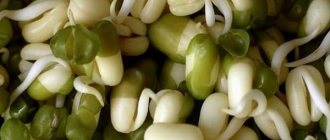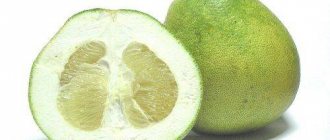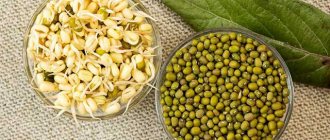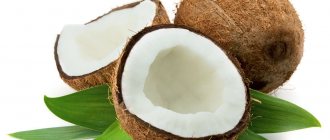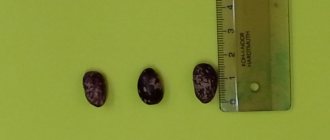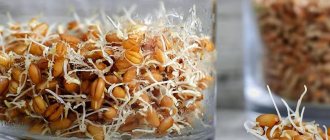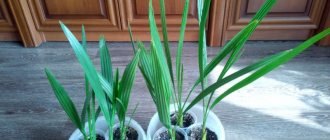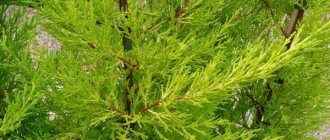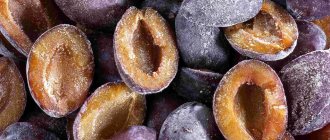Article about germinating different seeds on the website PP Delicious! Already there, I would like to dwell separately on how to germinate mung beans and why do it at all. Mash is a real find for anyone who cares about their health and adheres to proper nutrition, as well as for raw foodists, vegetarians and those simply losing weight. This legume, unusual for our cuisine, is very tasty and healthy, and when sprouted, its beneficial properties increase significantly.
What is mung bean
Mung bean (lat. Vigna radiata), or Indian bean, or mung, is an annual plant of the Vigna genus of the Legume family. Sometimes it is mistakenly called green bean, claiming that mung bean sprouts are very beneficial for the human body.
An ignorant reader may be confused, since green beans are also called green beans or asparagus beans. Mung bean is not a bean, although previously it was classified in this genus and called golden bean (lat. Phaseolus aureus, Phaseolus radiatus).
Mung beans have green beans that really look like small beans . The length of the beans ranges from 0.3 to 0.6 cm.
The historical homeland of mung bean is India. Since ancient times, Indians have cultivated mung bean, calling it “mung”. Fossilized mung beans have been discovered in central India and date back to 1500-1000 BC. e.
Chemical composition
Mung bean contains valuable vegetable protein, fiber, vitamins, minerals, protease inhibitors, and phytoestrogens, which can fully replace meat.
Sprouted beans provide the greatest value for humans, since the concentration of nutrients in them increases by 1.5 - 5 times.
Table No. 1 “Nutritional value of mung beans”
| Components | Content, g per 100 g of product [3] |
| Carbohydrates | 46 |
| Starch and dextrins | 42,4 |
| Squirrels | 23,5 |
| Water | 14 |
| Alimentary fiber | 11,1 |
| Mono- and disaccharides | 3,6 |
| Ash | 3,5 |
| Fats | 2 |
Table No. 2 “Chemical composition of mung beans”
| Name | Nutrient content, mg per 100 g of product |
| Vitamins | |
| Phylloquinone (K) | 0,009 |
| Ascorbic acid (C) | 4,8 |
| Pantothenic acid (B5) | 1,91 |
| Thiamine (B1) | 0,621 |
| Tocopherol (E) | 0,51 |
| Pyridoxine (B6) | 0,382 |
| Riboflavin (B2) | 0,233 |
| Niacin (B3) | 2,3 |
| Folic acid (B9) | 0,625 |
| Macronutrients | |
| Potassium | 1000 |
| Phosphorus | 358 |
| Magnesium | 174 |
| Calcium | 192 |
| Sodium | 40 |
| Microelements | |
| Iron | 6 |
| Zinc | 2,68 |
| Manganese | 1,035 |
The calorie content of mung beans and their sprouts is 300 and 30 kcal, respectively.
Useful properties of mung bean
The beneficial properties of mung bean are due to its composition:
- Polyunsaturated vegetable fats protect the heart and blood vessels and have a positive effect on metabolism.
- B vitamins have a beneficial effect on the condition of the skin and hair.
- Folic acid is indispensable for pregnant and lactating women, for the normal development of the fetus and the optimal composition of breast milk.
- Fiber helps the gastrointestinal tract and helps remove toxins and harmful substances from the body.
- Nanocoenzymes actively resist the negative effects of the environment on the skin, which makes cosmetic procedures using the plant one of the means to prolong the youth of the skin.
- Doctors advise diabetics to eat mung bean sprouts regularly as it maintains normal blood sugar levels.
- Chinese medicine uses a decoction of mung bean seeds for a whole list of diseases: digestive disorders, colds, swelling. Chinese traditional healers treat food poisoning with mung bean, in particular poisoning by mushrooms or poisonous plants. In their opinion, mung bean helps with poisoning by pesticides and heavy metals.
- These beans also accelerate the healing of thermal burns, have a diuretic effect, and remove harmful substances from the intestines.
Important ! Unfortunately, nutritionists do not recommend eating mung bean for obese people, since its energy value is very high - 300 kcal per 100 g.
But sprouts are a real godsend for those who want to lose weight. When sprouting, the beneficial qualities of beans are not only preserved, but even increased. The amount of protein in sprouts doubles, vitamin C increases seven times, the total content of antioxidants increases 5 times, and the energy value of sprouts, on the contrary, decreases 10 times and amounts to only 30 kcal per 100 g.
Features of application
Despite the high nutritional value and chemical composition, it is better to adhere to the daily intake. Sprouted mung bean does not require additional processing. Used in various ways:
- Fresh. The tasty sprouts are similar in taste to green peas. When consumed alone, digestibility increases.
- In the salad. Add to fresh vegetables, green salad. It is not recommended to mix with foods with a high protein content.
- In the form of fresh. It is rarely used in its pure form. Usually combined with fresh vegetables and fruits, herbs.
Vegetarians use mung bean as a base for making cutlets. But to do this, the sprouts are allowed to grow longer. Suitable for vegetable stews, but added at the end of cooking to preserve the beneficial properties.
Mung bean is a crop with unique properties. Contains a lot of useful vitamins, microelements and acids. It is well absorbed by the body and has a beneficial effect on various body systems. The harmful effects can be neutralized if you follow the consumption rate, restrictions, and do not use if there are contraindications.
Where to buy mung bean and how to store it
Dry mung bean can be purchased in grocery stores, supermarkets, markets or ordered online.
It’s more difficult with sprouted ones - you can really only find them in supermarkets in large cities. Should I be upset about this? No! Mung bean sprouted at home is fresher and healthier than store-bought. It is not at all difficult to germinate it yourself. The price of mung bean varies greatly - from 100 (on the market) to 450 rubles per 1 kg.
If you bought beans in a store in special packaging, they can be stored for the entire specified period provided the packaging is unopened. If the package is opened, it is better to put it in the refrigerator.
Important ! During storage, you should periodically sort through the beans, inspecting them for plaque or unpleasant odor.
It is not recommended to store packages of beans near heating devices (batteries, gas stoves, etc.), as the temperature and humidity of the air inside the package may increase, which will lead to rotting.
If you purchased beans at the market, when you get home, sort them out. Wrinkled or damaged seeds must be removed. The storage container should contain only completely dry and undamaged beans.
Pulses are stored well in canvas bags, previously boiled in a concentrated saline solution, thoroughly dried and ironed.
Why sprouted mung bean
In its usual (dry) form, mung bean is usually used in different ways for pp recipes - as a side dish, a base for first courses, etc. Sprouted recipes have no less, but the benefits are many times greater!
During germination, the beneficial properties of mung bean are not only preserved, but also increase, and not by some percentage, but on average 3 times! And the number of calories, on the contrary, decreases. Here is a comparison of the KBZHU of dry and sprouted mung bean:
- 100 g dry mung bean - 300 kcal/23.5 g protein/2 g fat/46 g carbohydrates
- 100 g of sprouted mung bean - 255 kcal , of which 39.1 g are carbohydrates, but I did not find exact information about how much fat and protein. It is only known that the digestibility of protein in sprouted beans increases by 30%!
You can often find information online that the calorie content of sprouted mung bean is 30 kcal. This is not true! This is the calorie content of the sprouts themselves - those little “antennae”. The total calorie content is much higher!
Mung bean sprouts strengthen the immune system, improve memory, stimulate mental activity, restore vision, and help prevent infectious and inflammatory diseases. They also normalize female hormonal levels and kidney function. In addition, sprouted mung bean is considered one of the most delicious legumes.
By the way, thanks to Wikipedia, I learned that mung bean, or rather starch from these beans, is the main component of funchosa. For some reason I always thought that “glass” vermicelli was made from rice.
How to germinate mung bean at home
To germinate mung bean at home use:
- Special equipment – sprouter seed germinator. The price for them ranges from 300 to 3000 rubles.
- Any suitable size bowl, plate or other container.
Of course, special equipment with an automatic irrigation system, maintaining temperature and air humidity will have a beneficial effect on the quality of seedlings.
However, given that mung bean seeds are large and germinate well and quickly, it is quite possible to get by with a deep soup plate, salad bowl or bowl.
What is needed for germination
You will need:
- 70 g or 3 tablespoons of dry mung beans (which will yield 210 g of sprouts after 31 hours);
- deep and wide dishes (choose them taking into account the fact that the number of beans triples during germination);
- 125 ml of boiling water.
Step-by-step instructions for germination
How to germinate mung beans at home:
- Sort the beans, discarding any debris and dry beans.
- Rinse under running water.
- Arrange the beans in the sprouter, preferably in one layer.
- Boil 125 ml of water and pour boiling water over them. Beans will not suffer from short-term exposure to boiling water, but pathogenic microflora will be destroyed.
- Place the dishes in a warm, wind-free place.
- After 8 hours, the beans will have absorbed almost all the liquid. Then you need to add more water, this time cooled and boiled, so that the beans are completely covered.
- During the day, you need to make sure that the beans do not dry out, but it is also not recommended to overfill them with water.
- Periodically rinse the beans under cold running water.
- After 31 hours, the length of the bean sprouts will be 0.3-0.5 cm.
- Continue to carefully water the mung beans, making sure that the seeds do not dry out.
- After 96 hours, the sprouts are ready to eat.
- Now you need to rinse the mung beans, carefully removing the green shells, and eat.
Note : The maximum benefit comes from seedlings no longer than 1 cm.
Conditions and timing of germination
If you carry out the germination procedure correctly and comply with all the conditions described below, then small roots and green stems will appear on the bean grains within 1-2 days.
In order for golden bean grains to sprout, they require certain conditions:
- seeds should be kept in a warm room at a temperature of +20...+23°C;
- there should be no drafts - this can lead to rotting of the seeds;
- the beans should always be slightly damp - this stimulates the growth of roots and the green part of the sprout;
- To prevent the seeds from becoming moldy during germination, you should not irrigate them with too much water. Periodic spraying will be enough to protect against drying out.
How to eat mung bean sprouts
Despite the fact that mung bean, unlike other legumes, contains a smaller amount of oligosaccharides that cause gas formation and complicate the digestion process, if digestion is impaired, its excessive consumption can cause dyspepsia and flatulence.
There is evidence in the literature that mung bean should be introduced into the diet with caution for pregnant and nursing mothers, children under 6 years of age, and people with allergies. Folic acid (vitamin B9), which is rich in sprouts, provides protection for the mother during pregnancy, improves the health of babies, and also prevents the risk of early birth and neural tube defects.
Attention ! Consult your doctor before use.
General recommendations
It is important to observe moderation when consuming sprouts. The daily intake should not exceed 60 g or 3 tablespoons.
How to improve the absorption of mung bean sprouts and reduce gas formation:
- Add spices: turmeric, ginger, asafoetida, coriander, pepper.
- Eat no more than 3 tablespoons per day.
- Try to eat sprouts only at lunchtime.
- Within 40 minutes after taking it, do not drink cold or too much.
- Try not to combine with animal products.
- Remember that any protein food requires an active lifestyle.
Salad with mung bean and avocado
Required:
- sprouted beans;
- fresh cucumber;
- iceberg lettuce;
- avocado;
- sweet bell pepper;
- flax seeds – 10 g;
- fresh parsley;
- spoon of white sesame seeds;
- sea salt;
- olive oil;
- ground black pepper;
- lemon juice - teaspoon.
Place the mung beans, soaked overnight and sprouted during this time, into a large bowl. Add to it a cucumber cut into half rings and bell pepper chopped into long strips. Chop the parsley randomly, and peel the avocado, remove the seed and cut into neat strips. Sprinkle with salt and sesame seeds and stir. Season with a mixture of olive oil and lemon juice. Decorate with parsley.
Recipes
Sprouted mung bean cutlets
Grind 1 cup of sprouts and 70 g of pre-boiled rice in a blender. Fry cumin, coriander and asafoetida, 1 teaspoon each, for 1-2 minutes in a frying pan, add 1 grated carrot to them and simmer for another 5 minutes. Combine the mixture of sprouts and rice with spices. The minced meat is ready. Add salt to taste, form cutlets and fry in a pan or steam.
Hearty smoothie
500 ml of water, a large handful of spinach, celery or parsley, 2 bananas, 2 tablespoons of mung bean sprouts, 5 dates add to a blender and blend.
Korean usage
In Korea, lightly boiled (less than 1 minute) mung sprouts are often served as a separate dish. Then cool and mix with sesame oil, garlic, salt, and other ingredients.
For lovers of hot and spicy Korean salad recipe:
Ingredients:
- 3 tablespoons of sprouts;
- 1 medium onion;
- 2 cloves of garlic;
- 1 teaspoon sesame seeds (white or black, preferably black and white);
- 1/3 teaspoon of monosodium glutamate (optional), a pinch of granulated sugar, hot pepper to taste, jalapeno (depend on your taste), if you don’t have fresh hot pepper, take coarsely ground chili, 2 peas of freshly crushed black pepper.
Preparation:
- Lightly rinse the mung bean sprouts and place in boiling water. After boiling, cook for 1 minute, then drain the water and drain the sprouts in a colander.
- At the same time, throw the black and white sesame seeds into a pre-heated frying pan and fry a little until the white sesame seeds are browned.
- Quickly discard the seeds into the prepared plate to prevent them from overcooking.
- Chop the onion as finely as possible and pour boiling water over it for 10-15 seconds. Chop the garlic.
- Combine onions, garlic, sesame seeds, cooled sprouts and add spices. Mix everything thoroughly and pour in hot, preferably sesame, oil and mix again.
- Before eating, let the salad sit for 15-20 minutes.
How to cook
Peel the fresh zucchini and cut into long slices. We turn each of them into a bunch of thin strips. Wash the sweet pepper, remove the core, cut into thin strips. We do the same with cucumbers and tomatoes.
In general, many oriental salads have the same cut: “thin twigs.” If it is not close to you and you want the dish to have large pieces that are pleasing to the eye and mouth, then you can cut it like that.
Chop the juicy leaves of Chinese cabbage in random order. Chop green onions into small circles. Mix all the listed ingredients, add lemon juice and a pinch of sea salt.
It turns out to be a magical, healthy, light and low-calorie salad. It can be served as an independent dish. Can be used as a side dish for meat, stewed vegetables or fried mushrooms.
Salad with meat
If you don’t follow a diet or simply decide to allow yourself a little more for lunch than usual, then we recommend preparing a very tasty, healthy and satisfying meat salad with sprouted mung bean. Sprouted legumes will give you strength, especially in winter, strengthen your immune system, and the meat component will add strength and satiate you for a long time.
- a handful of sprouted Indian peas;
- half a sweet salad onion;
- boiled (smoked) meat - any;
- oil;
- salt.
We germinate peas according to the principle already described above. The next morning you can prepare a salad from sprouted mung bean. The recipe with photo shows how beautiful and appetizing the dish looks. And it’s ready in a matter of minutes.
The meat (can be replaced with smoked sausage or ham) is cut into long bars and fried in oil. Then mixed with onions and sprouted Indian mung beans. You don’t even need to season the salad, since the oil from frying the meat will be enough.
Harm and contraindications
Mung bean dishes are contraindicated for certain groups of people:
- Those with individual intolerance (consult a doctor before use).
- Suffering from intestinal motility disorders.
- Suffering from gastritis and ulcers. There is too much fiber in mung bean. If the body suffers from these diseases, it will be very difficult for it to digest the product, flatulence may occur and painful sensations may appear. For the same reason, the product is not recommended for use by young children (the permitted age is to be confirmed with a pediatrician).
